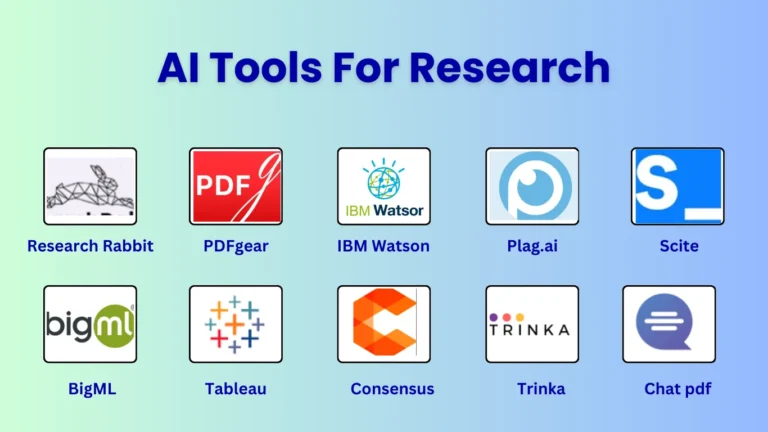In the ever-evolving research landscape, integration of artificial intelligence (AI) tools has become common, revolutionizing the way education solves complex problems. The intersection of advanced methodology, machine learning and data analysis has resulted in a series of
Powerful tools designed to enhance and accelerate research in a variety of fields. From finding patterns in large databases to natural language processing to simplifying complex models, AI tools are becoming increasingly important for researchers looking for innovative solutions.
This collection examines 10 AI tools that have proven essential in advancing research. From open machine learning libraries to multiprocessor platforms that provide artificial intelligence services, these tools meet the diverse needs of researchers in fields like computer science, linguistics, and the like.
Data Analysis. By examining the capabilities of each tool, it is clear that the collaboration between human intelligence and artificial intelligence opens up a new era in analytics. These tools not only provide efficiency and accuracy to researchers but also pave the way for new discoveries and insights
Earlier, these were unimaginable. Join us as we explore 10 search-related innovations and AI tools that unleash the potential to revolutionize knowledge retrieval.
Table of Contents
Overview of AI Tools For Research
In the ever-changing field of research, it is now important for those in the education sector to seek new solutions to utilize cutting-edge artificial intelligence (AI) tools. The platforms included in the top 10 AI tools for educational research are diverse, and each has special strengths that can improve and accelerate the research process.
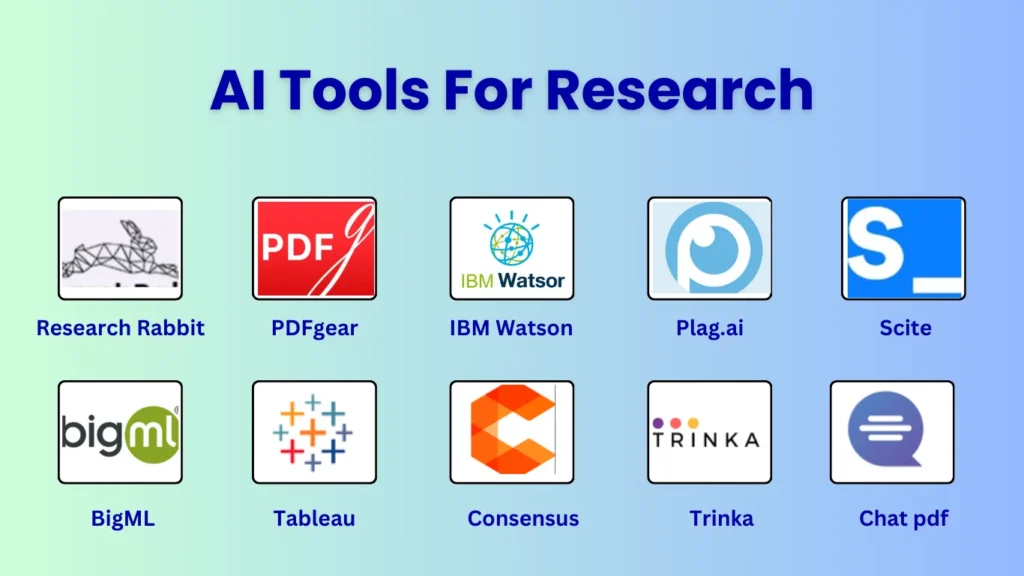
Research Rabbit is unique among them all. offering a clever mechanism for effective information analysis and retrieval. Consensus uses AI-powered algorithms to support group decision-making, whereas Trinka specializes in supporting researchers by providing writing assistance. Plag.ai proves to be the most important tool for
upholding the integrity of research by identifying and stopping plagiarism. Tableau is unmatched for perfect data visualization, enabling researchers to quickly and easily convert unprocessed data into beneficial insights.
While Scite uses AI to assess the validity of scientific references, BigML provides researchers with a natural machine-learning platform. Providing a range of AI services, including image recognition, machine learning, and natural language processing, IBM Watson continues to be a mainstay.
All ten of these AI research tools—including Chat PDF—help to transform the field of study, increase productivity, and open up new directions for exploration. Research Rabbit, Chat PDF, Consensus, Plag.ai, Tableau, BigML, Scite, IBM Watson, and the Top 10 AI Tools for Research Let’s have a brief introduction
1. Research Rabbit: Top 10 AI Tools For Research
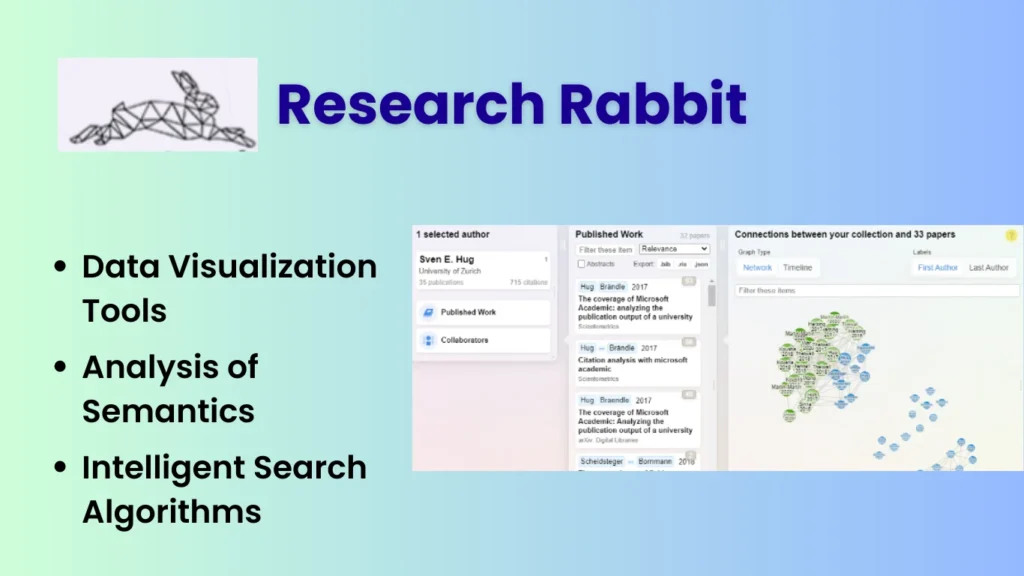
Research Rabbit is a web-based platform that helps researchers find and visualize relevant literature and helps researchers base their research on one or more original articles. Research Rabbit uses various algorithms, such as citation analysis, semantic search, and natural language processing.
to recommend and map related articles and authors along with abstracts, citations, and links. Research Rabbit can also help researchers share their collections, collaborate with others, and track their progress. Research Bunny is a useful tool for literature research, data analysis, and knowledge discovery
Qualities: 👇👇
⭐Intelligent Search Algorithms: Advanced intelligent user search technology by Research Rabbit goes beyond simple keyword searches. Because of its advanced abilities, users can find pertinent information and hidden connections that traditional search methods might miss.
⭐Analysis of Semantics: By applying advanced natural language processing (NLP) methods, the tool conducts comprehensive semantic analysis, enabling scholars to understand the context of data. This guarantees greater awareness of the topic.
⭐Data Visualization Tools: Research Rabbit offers powerful data visualization tools that help turn incomplete information into helpful understandings. This makes it easier for researchers to explain their results in a way that is both effective and clear.
2. Chat pdf: Top 10 AI Tools For Research
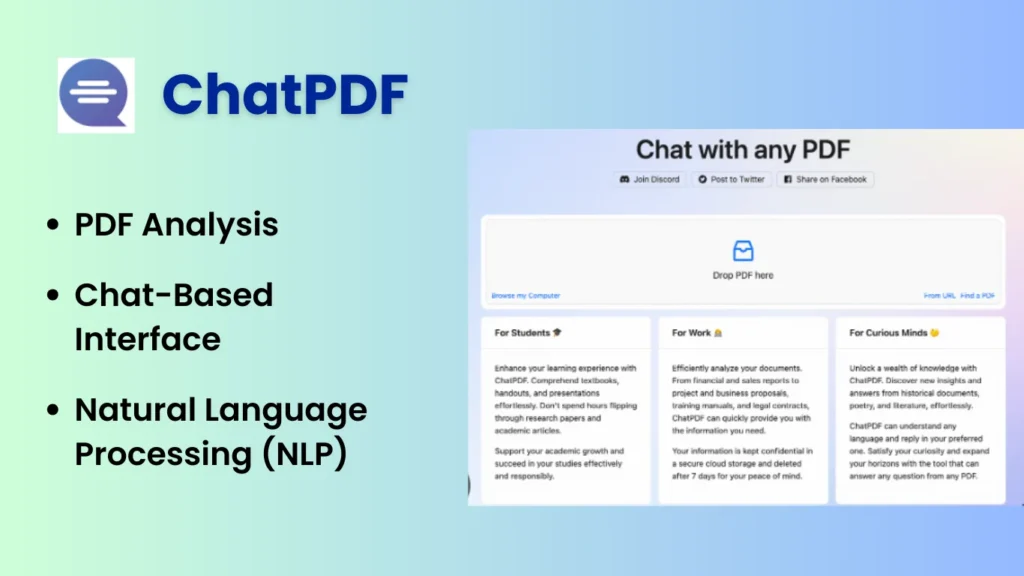
The Chat PDF AI Tool is a revolutionary solution that will improve your research experience. Staying ahead in the fast-paced world of information and technology demands having strong tools that not only offer incomparable productivity but also optimize your workflow.
Our Chat PDF AI Tool is specifically designed to fulfill these needs, offering a smart and user-friendly platform for your research activities. The Top 10 AI Research Tools In the field of research, there is a constant search for the best tool.
Our Chat PDF AI Tool is one of the Top 10 AI Tools for Research, and it stands out among the many options available. Let’s examine the features that make it unique.
features 👇👇
🤜Natural Language Processing (NLP): By using advanced NLP algorithms, our AI tool can accurately read and interpret human language. This makes the interaction smooth and easy to use, which improves the simplicity of your research process.
🤜Chat-Based Interface: Using a chat-based interface, have a dialogue with our AI tool to make your interactions easy and conversational. This feature makes sure that the way you interact with the tool feels natural to you.
🤜PDF Analysis: With this tool, which specializes in PDF analysis, you can easily extract important information from PDF documents. Our AI tool thoroughly examines PDFs, including text, tables, and images, to give you pertinent insights.
3. Trinka: Top 10 AI Tools For Research
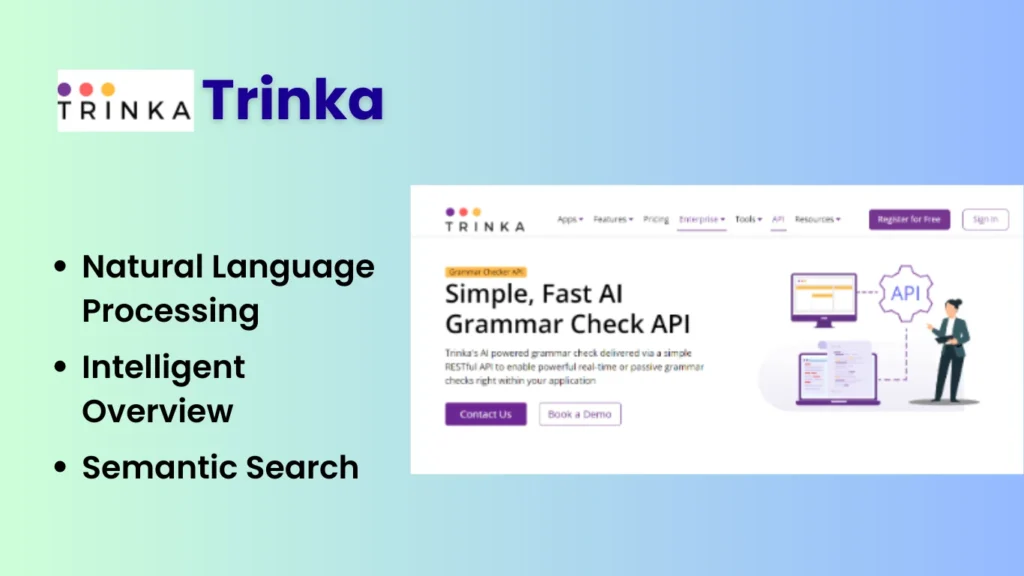
declaring Trinka AI Tool: Unlocking Intelligence’s Potential in Research There has never been a greater need for effective and innovative tools in the dynamic field of research. Here comes Trinka AI, a ground-breaking tool meant to take research to levels that were never before possible. As one of the Top 10 AI Tools for Research,
Trinka AI stands out in this age of technological advancements where information is plentiful but complex. Its features redefine the way we look at knowledge discovery.
Important features: 👇👇👉
👉Natural Language Processing (NLP): Trinka AI has cutting-edge NLP skills that enable users to communicate with the tool in a conversational way. This methodical approach makes communication easier and simpler than before, even for complex questions.
👉Semantic Search: Discover how to use semantic search to get results that go beyond simple keyword matches. Trinka AI provides more pertinent and sensitive data that is customized to your research needs by understanding the context and relationships within the text.
👉Intelligent Overview: Weary of leafing through countless pages of data? The intelligent summarization function of Trinka AI helps you save time and make sure that you understand the main points of lengthy documents by distilling them into clear, informative summaries.
4. Consensus: Top 10 AI Tools For Research
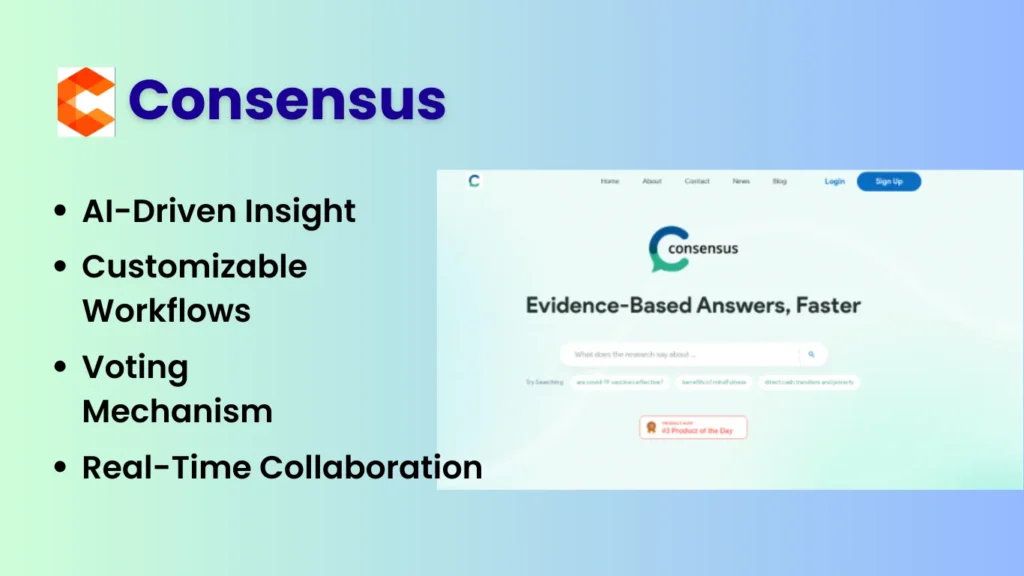
In the dynamic landscape of research and decision-making, efficiency and accuracy are paramount. Our Consensus Tool is a beacon of innovation, integrating seamlessly into your workflow to facilitate smooth collaboration and data-driven decision-making.
This tool harnesses the power of artificial intelligence to enhance consensus-building processes, ensuring that teams can navigate complex choices with precision and ease.
features 👇👇
- AI-Driven Insights: Take advantage of artificial intelligence’s advanced abilities to examine data, patterns, and trends to give teams insightful information to help them make decisions.
- Real-Time Collaboration: Enable team members to share, debate, and improve ideas at the same time by using a real-time collaboration feature to break down communication barriers.
- Voting Mechanism: To ensure that choices represent the team’s collective wisdom, employ a strong voting system to decide preferences and rank options.
- Customizable Workflows: Create workflows that are compatible with your particular decision-making processes to better adjust the tool to the particular requirements of your team.
5. Tableau: Top 10 AI Tools For Research
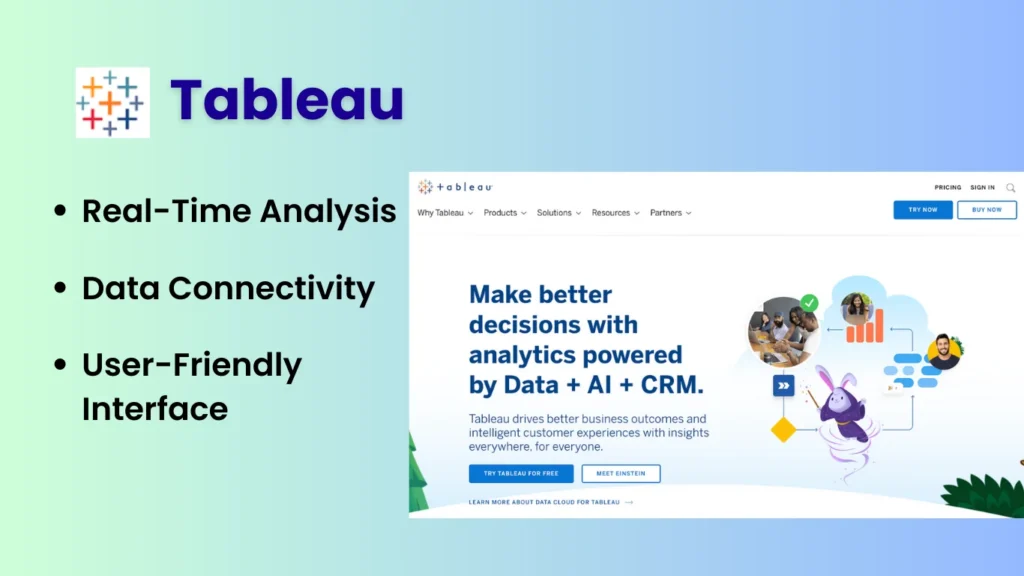
Tableau is an amazing tool that helps people and organizations understand complex datasets in the ever-changing field of data analysis and visualization. Tableau, ranked among the Top 10 AI Tools for Research, enables users to create meaningful insights from unstructured data by utilizing interactive and user-friendly visuals.
features 👇👇
- User-Friendly Interface: Tableau has a simple interface that makes it possible for analysts of all skill levels to produce powerful visualizations without requiring a lot of coding expertise.
- Data Connectivity: It ensures flexibility in data integration by supporting smooth connectivity to a variety of data sources, including databases, spreadsheets, and cloud-based platforms.
- Real-Time Analysis: Tableau’s real-time data analysis feature enables users to keep up with emerging trends and make well-informed decisions using up-to-date knowledge.
6. BigML: Top 10 AI Tools For Research
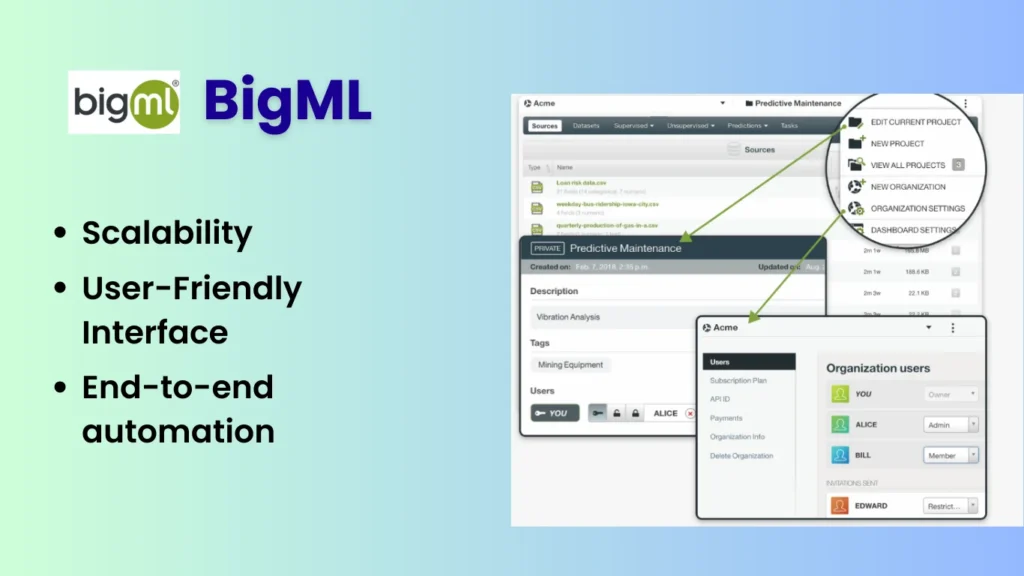
Researchers and data scientists are always searching for innovative tools to improve their methods and enable them to derive valuable insights in the ever-changing field of artificial intelligence. BigML is a strong contender among the many options available and has earned a spot on the list of the Top 10 AI Tools for Research.
features 👇👇
⭐User-Friendly Interface: BigML has an easy-to-use interface that is suitable for both novices and experienced machine learning professionals. The platform is designed with simplicity in mind, but not at the expense of machine learning’s depth and complexity.
⭐End-to-end automation: BigML’s dedication to automation is one of its most notable features. BigML automates the whole machine learning process, from data preparation to model deployment, freeing researchers to concentrate on interpreting findings rather than figuring out complicated technical steps.
⭐Scalability: BigML is capable of handling diverse scenarios, including small-scale projects and large datasets. Because of its scalable infrastructure, you can go from model to production with ease and without losing performance.
7. Scite: Top 10 AI Tools For Research
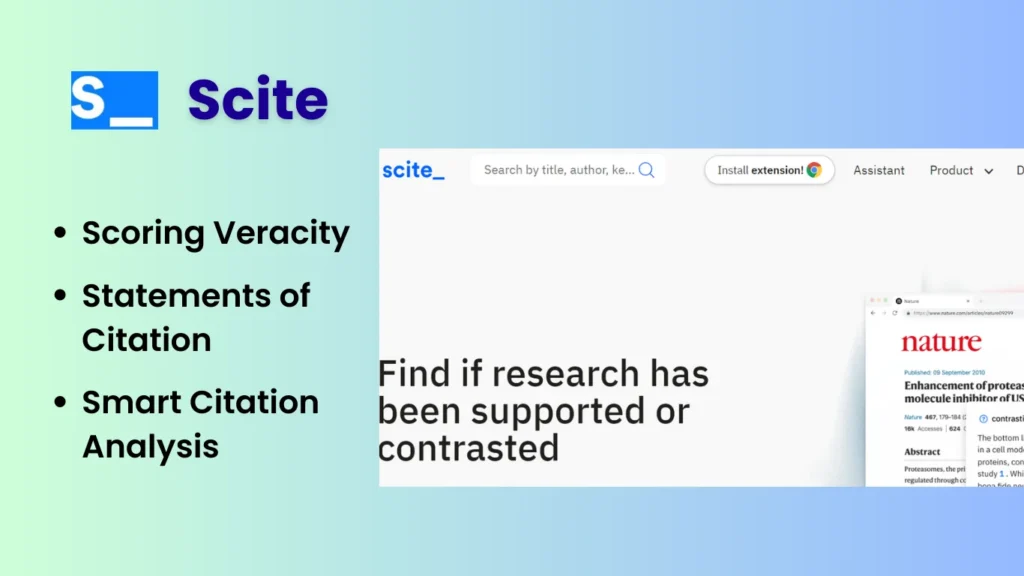
In the ever-changing field of research, it is important to stay up-to-date on the most recent advances. The increasing number of scholarly articles makes it difficult to identify the most important and relevant research. This is where Scite, which is ranked among the Top 10 AI Tools for Research, proves to be extremely useful.
features 👇👇
🤜Smart Citation Analysis: Cite Scite goes beyond the conventional reference count by analyzing references using state-of-the-art artificial intelligence. It evaluates the feelings and context of citations, offering a more complex viewpoint on the importance of a specific research work.
🤜Statements of Citation: By extracting and highlighting reference statements, the tool provides researchers with a brief overview of how a paper has been cited. This feature contributes to a more thorough literature review by making it easier to determine whether a paper has been cited in support or criticism.
🤜Scoring Veracity: Scite evaluates a paper’s citation accuracy to determine how credible it is. This guarantees that researchers use data from reliable and reputable sources, improving the caliber of their work as a whole.
8. Plag.ai: Top 10 AI Tools For Research
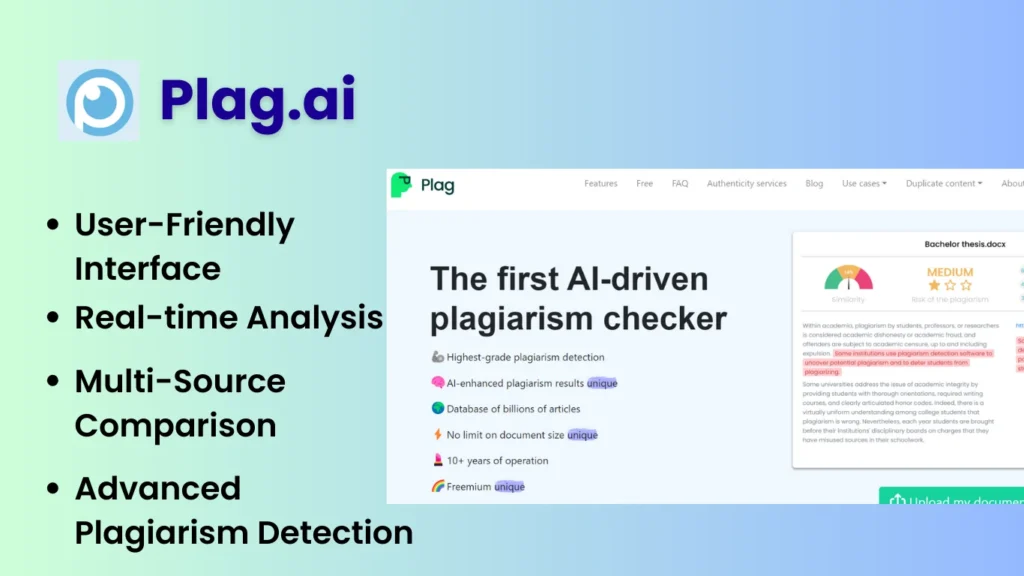
Plag.ai: The Best Way to Ensure Research Authenticity Keep your work honest at all times. Academic and research activities are dynamic environments. Plag.ai is a novel tool that aims to support academics and researchers in their pursuit of authenticity and uniqueness.
It is more important than ever to have a reliable plagiarism detection tool in this age of abundant information. Plag.ai is a shining example for people and organizations that aim for excellence.
features 👇👇
- Advanced Plagiarism Detection: Plag.ai uses advanced algorithms to carefully examine content and spot instances of plagiarism, providing a thorough and exact evaluation.
- Multi-Source Comparison: The program looks at more than just one database. Plag.ai provides a comprehensive analysis of your work by scanning a wide range of academic databases, publications, and online sources.
- Real-time Analysis: Plag.ai works in real-time, providing quick outcomes to speed up the writing and research process without sacrificing accuracy.
- User-Friendly Interface: Plag.ai guarantees a seamless experience for researchers, educators, and students alike with its intuitive and user-friendly interface. Even for people without a lot of technical experience, the tool is made to be effective and easy to use.
9. IBM Watson: Top 10 AI Tools For Research
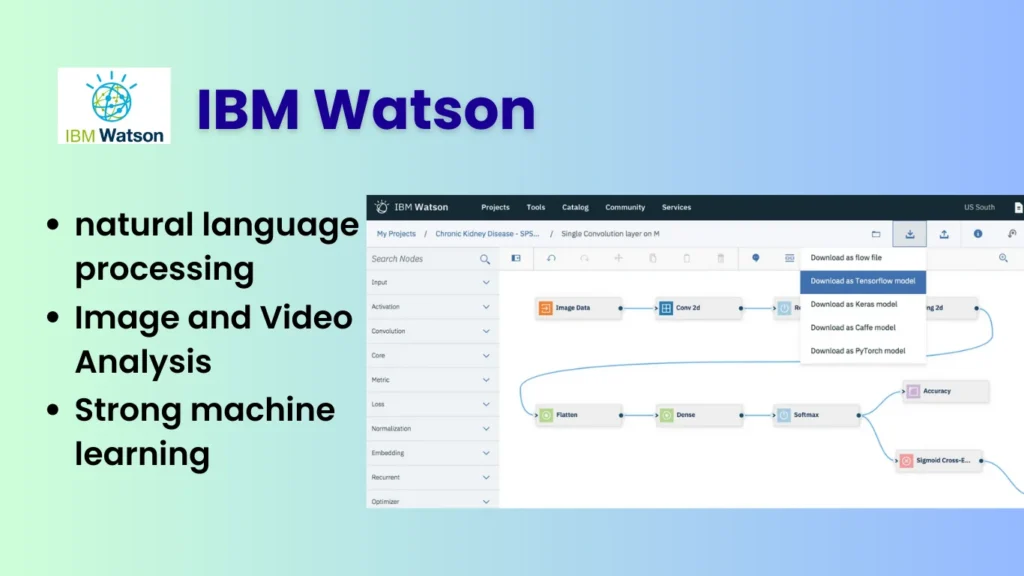
With a broad range of tools to help unlock data’s potential and enable transformative insights, IBM Watson is a leader in the rapidly changing field of artificial intelligence. IBM Watson continues to change how businesses approach data analysis, decision-making, and problem-solving as one of the coveted Top 10 AI Tools for Research.
features 👇👇
👉Through the use of natural language processing, or NLP, IBM Watson is able to understand and generate text that is similar to that of a human, allowing users to communicate with the system in a more conversational and intuitive way.
👉Strong machine learning algorithms on the platform enable researchers to make well-informed decisions by analyzing large datasets and identifying patterns, trends, and correlations.
👉Image and Video Analysis: IBM Watson provides tools for image recognition and video analysis, expanding its capabilities to include visual data. For researchers who work with multimedia content, this is invaluable.
10. PDFgear: Top 10 AI Tools For Research
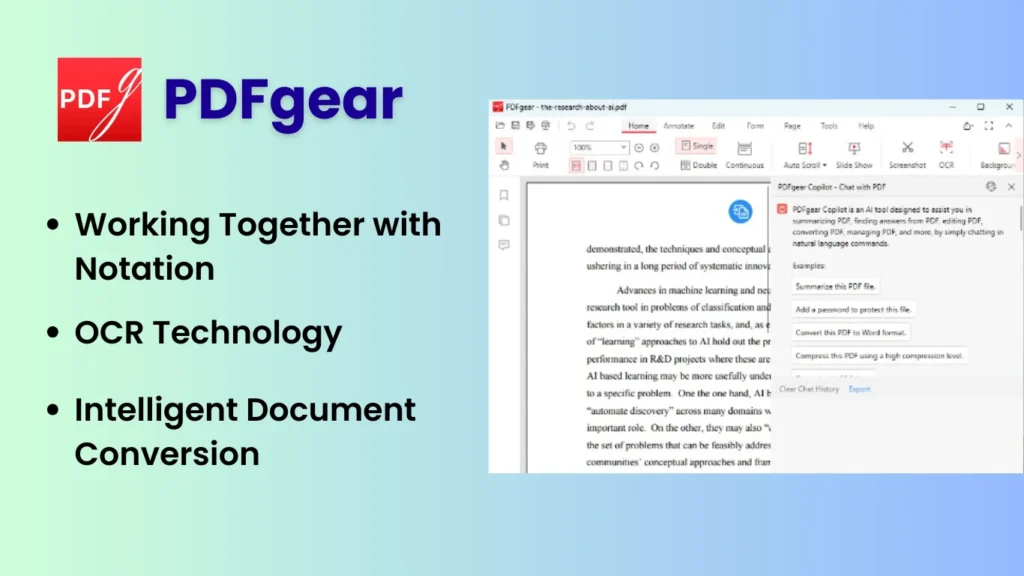
With its ability to simplify your document-related tasks, PDFgear stands out as a highly versatile and indispensable tool in the constantly changing field of information management. As one of the leading providers of AI tools for research, PDFgear stands out for its dedication to improving
accessibility and efficiency while providing a wide range of robust features to satisfy the needs of scholars, professionals, and researchers alike.
features 👇👇
🤜Intelligent Document Conversion: PDFgear is highly skilled at smoothly converting a wide range of document formats to and from PDF. With PDFgear, you can work with Word, Excel, or PowerPoint files and still maintain formatting and content integrity during the conversion process.
🤜OCR Technology: Discover how to use optical character recognition (OCR) to turn scanned documents into text that can be edited and searched. The advanced OCR features of PDFgear improve the digital age and make handling image-based documents more effective.
🤜Working Together with Notation: Use tools for annotation to make collaboration easier. With the help of PDFgear, users can highlight, remark, and annotate PDFs, promoting productive collaboration and feedback in academic settings and research teams.
Conclusion
In conclusion, the academic research tool landscape has changed completely, offering a wide range of effective resources to meet a variety of needs. Research Rabbit, Chat PDF, Trinka, Consensus, Tableau, BigML, Scite, IBM Watson, Plag.ai, and PDFgear are among the top 10 AI research tools that show the
revolutionary effects of AI on the research process. These tools help to improve efficiency and accuracy in research endeavors, in addition to optimizing data analysis and visualization. Researchers can use these state-of-the-art AI tools to navigate the ever-expanding information domain and spur innovation in their respective fields as technology continues to progress.
Is There Any AI To Write Research Papers?
With Smodin’s Free AI Research Paper Generator & Writer, you can wave goodbye to writer’s block! With the use of sophisticated algorithms and a thorough analysis of millions of papers, Smodin’s AI-powered tool produces research papers of the highest caliber.
Can I Use AI To Write My Thesis?
Yes, artificial intelligence can help you with thesis writing. The writing process can be streamlined in a number of ways by using AI tools, including data analysis, literature reviews, grammar checks, and content refinement.
Can I Use Open AI For Research?
Our models are employed in production for developer use cases as well as research. Scholars frequently become aware of our models through publications we have written, however there is frequently a difference between the content published in a paper and what is accessible through the OpenAI API.
How Do I Start Researching AI?
Step 1: Get a computer information science bachelor’s degree.
Improve Your Technological Fluency in Step Two.
Step 3: Look for a Job in the AI Industry.
Step 4: Keep Up with AI Developments.
Can AI Write My Phd?
Though it won’t write your thesis, an AI might write one of its own. While writing coherently is important, it’s even more important to read critically, ask insightful questions, and respond to criticism—all skills that AI isn’t (yet) able to perform. This is something you’ll learn in the first year seminar.

